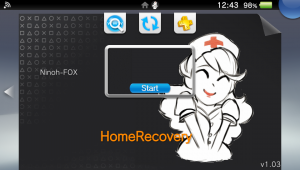More actions
No edit summary |
|||
| (2 intermediate revisions by the same user not shown) | |||
| Line 2: | Line 2: | ||
|title=Vita Homebrew Apps (System Tools) - GameBrew | |title=Vita Homebrew Apps (System Tools) - GameBrew | ||
|title_mode=append | |title_mode=append | ||
|image= | |image=homerecoveryinstallervita2.png | ||
|image_alt=HomeRecovery installer | |image_alt=HomeRecovery installer | ||
}} | }} | ||
{{Infobox Vita Homebrews | {{Infobox Vita Homebrews | ||
|title=HomeRecovery installer | |title=HomeRecovery installer | ||
|image= | |image=homerecoveryinstallervita2.png | ||
|description=PS Vita Recovery menu using Enso 3.60 and 3.65. | |description=PS Vita Recovery menu using Enso 3.60 and 3.65. | ||
|author=Ninoh-FOX | |author=Ninoh-FOX | ||
|lastupdated=2018/ | |lastupdated=2018/03/26 | ||
|type=System Tools | |type=System Tools | ||
|version=1.03 PSTV | |version=1.03 PSTV | ||
Latest revision as of 04:48, 9 December 2022
| HomeRecovery installer | |
|---|---|
 | |
| General | |
| Author | Ninoh-FOX |
| Type | System Tools |
| Version | 1.03 PSTV |
| License | Mixed |
| Last Updated | 2018/03/26 |
| Links | |
| Download | |
| Website | |
| Source | |
PS Vita Recovery menu using Enso 3.60 and 3.65. Originally based on the HomeRecovery plugin.
Note: While this could help recover your Vita, it is still a risk to install and if done incorrectly could stop you booting into the shell, install at your own risk.
Features
- Starts before the main menu, only push R button when the Enso boot logo screen change of color.
- Change boot IDU on or IDU off (quit demo mode).
- Backup Activations files and Tai configs.txt. and recovers the files too.
- Erase id.dat, act.dat, ux0:tai/config.txt, ur0:tai/config.txt or Registrion files.
- Mount or Unmount MCard.
- Inject Molecular in Near or change Near(mod) for Vitashell (and restore everything too)
- Uninstall Recovery option in recovery menu.
- In Spanish and English.
- PSTV compatible.
Installation
Install the VPK with VitaShell.
To uninstall, go to the recovery menu > extras, then select the last option.
User guide
Menu options
Menu: ------continue: boot normal, exit of Recovery
|
----BOOT:----Reboot
| |--IDU on
| |--IDU off (demo mode)
|
----Fixes:---Erase id.dat
| |--Erase act.dat
| |--Erase ux0 tai config
| |--Erase ur0 tai config
| |--Erase Registre
| |--Erase Database
|
----Mount:---Mount ux0 (Mcard)
| |-Unmount ux0
|
---Backup:---Copy activation
| |-Restore activation
| |-copy ur0 tai config
| |-restore ur0 tai config
| |-copy ux0 tai config
| |-restore ux0 tai config
| |-copy database
| |-restore database
|
---Extras:---Install VITASHELL
|-Install MOLECULAR
|-Inject Molecular in NEAR
|-Inject Vitashell in NEAR
|-Restore to factory NEAR
|-Sistem info (imei and cid)
|-Uninstall Recovery (restore boot_config)
|-clean Log"
Changelog
v1.03
- Fixed NEAR operations, Now NEAR is restored from the same vpk data, in the menu. Now the option to install MOLECULAR has been implemented, the option of injecting VITASHELL in its entirety into NEAR has been implanted, the only thing that has resisted me is the icons when doing NEARMOD, the order is lost, I am sorry but could not do anything about it if I want it NEARMOD work.
v1.02
- Fixed when icons / bubbles are messed up when doing operations on near or installing vitashell.
v1.01
- Fixed when restore NEAR mode2 missing pic0.png.
V1.00
- Copy and restore Database, Erase Database, install Vitashell from recovery menu, Inject Molecular in NEAR without have Molecular installer in the console (mode2). Clean and optimize de code. Fixs. Now the vpk detected firmware of the console for install the correct module, now PSTV compatible. Change icon style from livearea.
v0.93
- VPK installer HomeRecovery (add option uninstall inside recovery menu).
v0.92
- only clean the code.
v0.91
- Added the option to inject Vitashell after making the copy of Molecular. Corrected graphic failures in the processes.
v0.9
- Now you can replace NEAR® with MolecularShell, create a backup in the process and restore to the previous state if necessary.
v0.5
- Now you can make backups and restores of the activation files or the Tai config.txt files.
